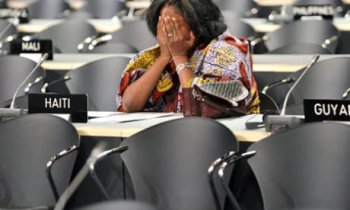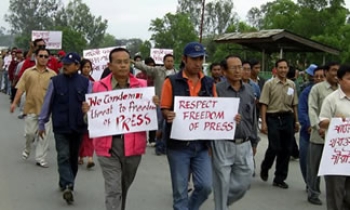A couple of parts of the traditional English landscape changed significantly this week.
Not only did the country's much-maligned cricket team--eventually and after much anxiety--regain The Ashes (a sporting trophy the origin of which, like the game itself, perpetually confounds brief description), but there is now an unfamiliar presence on news stands each morning.
The Guardian, the venerable newspaper beloved of British liberals, abandoned its broadsheet format as part of an extensive design revamp. The paper has adopted the "Berliner" size--somewhere between broadsheet and standard tabloid--popular among continental European papers such as France's Le Monde, but a first for the British market.
Since debuting in 1821 as the Manchester Guardian, and still owned by a nonprofit trust, the paper has long been a home for alternative viewpoints and forceful commentary, while establishing a reputation for setting the intellectual agenda on the center-left with committed argument and good humor.
Often affectionately ridiculed for its misprints (it is commonly known as "The Grauniad" from the time some years back when it misspelled its own name as an anagram on the front page), it famously once ran a paragraph in its "Corrections and Clarifications" column that said: "The nonappearance of this column yesterday was due to space constraints, not a sudden outbreak of accuracy."
Alan Rusbridger, the paper's editor, wrote in the first edition that the new format was "in response to unambiguous research which shows that readers increasingly find broadsheet newspapers difficult to handle in many everyday situations, including commuting to work."
"But," he went on, "our research showed equally clearly that there were many things readers didn’t want changed--including our comprehensive commitment to news and the intelligence and seriousness of our coverage and comment. They welcomed a wide variety of views, but they wanted news first."
The Guardian is no stranger to innovation. A decade ago, it produced a restaurant menu-sized, indestructible "paper of the future," heavy on elements of personalization. Its Web site, meanwhile, has hugely increased the audience for the news brand across the globe.
Now, the paper has invested some £80 million ($145 million) in new presses to handle its redesign. An upside is that it can offer color on every page, a potential advantage for advertisers who might obviously be disinclined to pay the same rate for a smaller-size display.
The paper's move follows decisions by its competitors, The Independent and Rupert Murdoch's Times, to shift to a tabloid--or, in their preferred terminology, "compact"--form in 2003. After a period of publishing in both formats, they both eventually abandoned broadsheets last year.
For The Times, the move came after 216 years publishing in its traditional format. But tradition clearly counts for little in the contemporary information marketplace. Given Murdoch’s recently demonstrated commitment to the Internet, News Corp. (nyse: NWS - news - people ) is positioning itself to be a even bigger player in the online information environment.
Britain's so-called "mid-market" papers, the Daily Mail and Daily Express, had changed some decades ago from broadsheet to tabloid to encourage commuter readers, and, as Rusbridger pointed out, this was partly the motivation behind the most recent shift. "No paper ever stands still," he wrote.
One of The Guardian's slogans for its new format is: "Now it's easier to get to grips with the issues."
While the broadsheet Sunday papers--theoretically a more leisurely read--such as the Sunday Times and the Guardian's publishing partner The Observer, remain in the larger format, this week's shift leaves The Daily Telegraph and the Financial Times as the remaining daily broadsheets. Since the Telegraph--one of Britain’s pioneering papers online--has traditionally had an older readership, it has been considering the advantages of appealing to a younger audience through different formats.
The Guardian hopes the new design will also help tackle the slippage in its circulation, currently at 340,000--down 6% over last year.
But it's still early, and the jury is out on the new design--"bitty" was the opinion of one television reviewer--while the linear front-page template is more traditional than the Independent's single-story, magazine-like fronts.
The Guardian continues the trend--reinvented by The Independent nearly two decades ago--toward telling stories using a strong visual statement. The center spread in Monday’s edition was given over to a single, dramatic photograph of rioting in Northern Ireland.
There also appears to be a much closer handshake between hard-copy and digital editions, with much emphasis laid on effective signposting, indexing and cross-referring from the paper to the Web. While it gave a fascinating behind-the-scenes insight, somehow something seemed disconnected reading about the evolution of the dead-tree edition on the special report online dealing with the new paper’s creation.
Like other media, The Guardian has been keen to encourage audience involvement, and promote fledgling "citizen journalism." So readers have been given many opportunities to comment on the project.
On launch day, initial reactions online appeared supportive but cautious. In almost typical "Guardian reader" fashion, many seemed more concerned about the number of computer screens left on overnight in pictures of the newsroom than the controversial lower case, single-word masthead.
Until this week, it had been almost 20 years since an English cricket team had won The Ashes. In that period, the newspaper industry has undergone more fundamental structural change than in the last two centuries. But the newspaper audience has likewise dramatically altered. The challenge for news organizations in the next 20 years is to make sure that, whatever their products look like, they still have something relevant to say.









